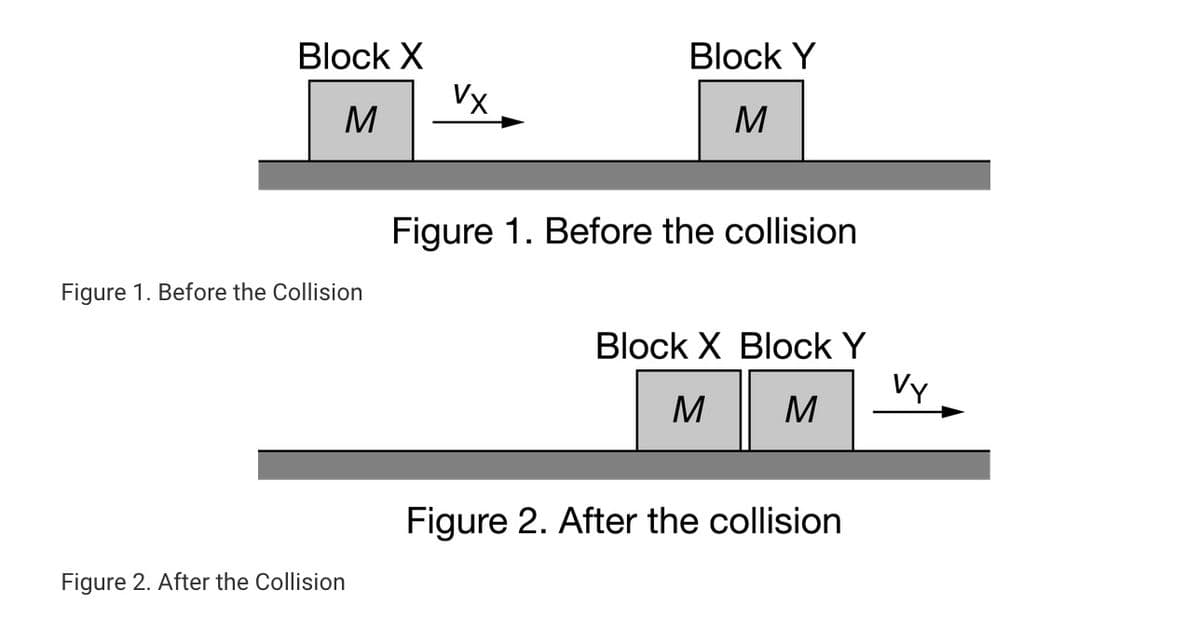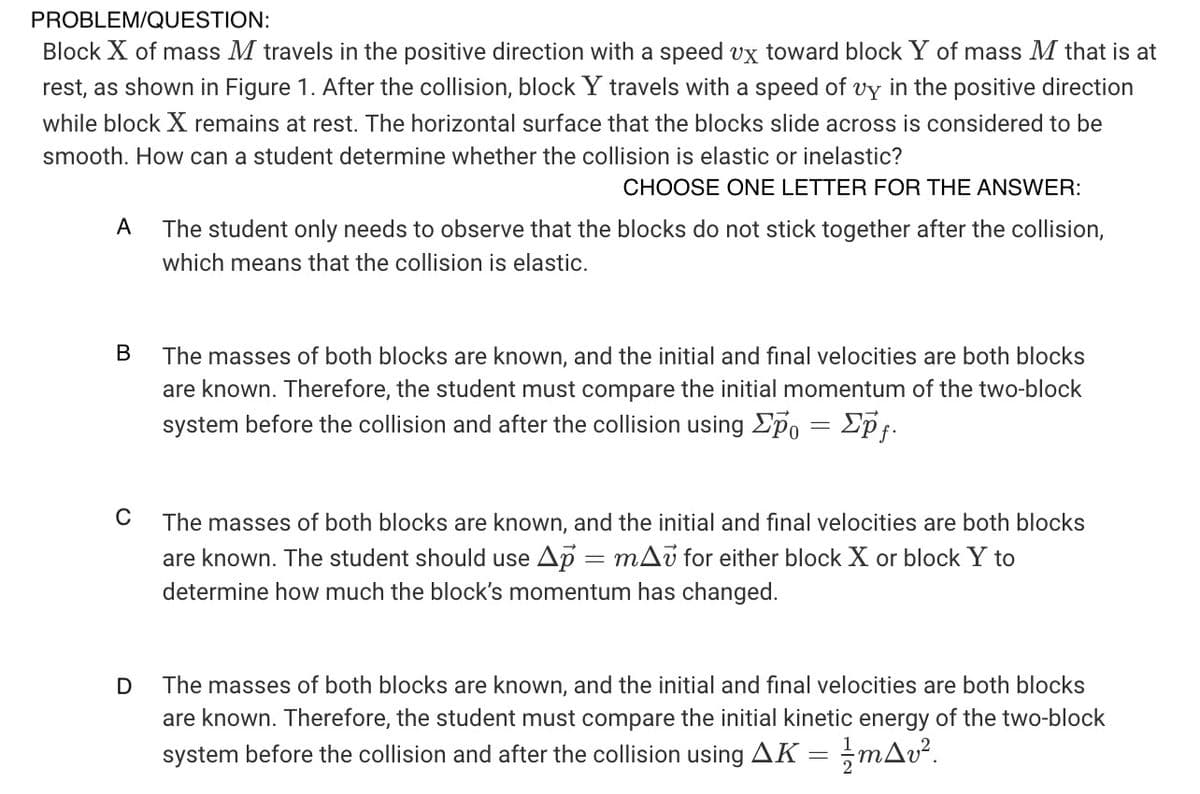Block X of mass M travels in the positive direction with a speed vx toward block Y of mass M that is at rest, as shown in Figure 1. After the collision, block Y travels with a speed of vy in the positive direction while block X remains at rest. The horizontal surface that the blocks slide across is considered to be smooth. How can a student determine whether the collision is elastic or inelastic? CHOOSE ONE LETTER FOR THE ANSWER: A The student only needs to observe that the blocks do not stick together after the collision, which means that the collision is elastic. B The masses of both blocks are known, and the initial and final velocities are both blocks are known. Therefore, the student must compare the initial momentum of the two-block system before the collision and after the collision using Epo = Epf. The masses of both blocks are known, and the initial and final velocities are both blocks are known. The student should use Ap = mAu for either block X or block Y to determine how much the block's momentum has changed. D The masses of both blocks are known, and the initial and final velocities are both blocks are known. Therefore, the student must compare the initial kinetic energy of the two-block system before the collision and after the collision using AK = ;mAv².
Block X of mass M travels in the positive direction with a speed vx toward block Y of mass M that is at rest, as shown in Figure 1. After the collision, block Y travels with a speed of vy in the positive direction while block X remains at rest. The horizontal surface that the blocks slide across is considered to be smooth. How can a student determine whether the collision is elastic or inelastic? CHOOSE ONE LETTER FOR THE ANSWER: A The student only needs to observe that the blocks do not stick together after the collision, which means that the collision is elastic. B The masses of both blocks are known, and the initial and final velocities are both blocks are known. Therefore, the student must compare the initial momentum of the two-block system before the collision and after the collision using Epo = Epf. The masses of both blocks are known, and the initial and final velocities are both blocks are known. The student should use Ap = mAu for either block X or block Y to determine how much the block's momentum has changed. D The masses of both blocks are known, and the initial and final velocities are both blocks are known. Therefore, the student must compare the initial kinetic energy of the two-block system before the collision and after the collision using AK = ;mAv².
College Physics
1st Edition
ISBN:9781938168000
Author:Paul Peter Urone, Roger Hinrichs
Publisher:Paul Peter Urone, Roger Hinrichs
Chapter34: Frontiers Of Physics
Section: Chapter Questions
Problem 22CQ: Must a complex system be adaptive to be of interest in the field of complexity? Give an example to...
Related questions
Question
MULTIPLE CHOICE QUESTION

Transcribed Image Text:Block X
Block Y
Vx
M
Figure 1. Before the collision
Figure 1. Before the Collision
Block X Block Y
Vy
M M
Figure 2. After the collision
Figure 2. After the Collision

Transcribed Image Text:PROBLEM/QUESTION:
Block X of mass M travels in the positive direction with a speed vx toward block Y of mass M that is at
rest, as shown in Figure 1. After the collision, block Y travels with a speed of vy in the positive direction
while block X remains at rest. The horizontal surface that the blocks slide across is considered to be
smooth. How can a student determine whether the collision is elastic or inelastic?
CHOOSE ONE LETTER FOR THE ANSWER:
А
The student only needs to observe that the blocks do not stick together after the collision,
which means that the collision is elastic.
В
The masses of both blocks are known, and the initial and final velocities are both blocks
are known. Therefore, the student must compare the initial momentum of the two-block
system before the collision and after the collision using Ep, = Epf.
C
The masses of both blocks are known, and the initial and final velocities are both blocks
are known. The student should use Ap = mAu for either block X or block Y to
determine how much the block's momentum has changed.
The masses of both blocks are known, and the initial and final velocities are both blocks
are known. Therefore, the student must compare the initial kinetic energy of the two-block
system before the collision and after the collision using AK = ;mAv².
Expert Solution
This question has been solved!
Explore an expertly crafted, step-by-step solution for a thorough understanding of key concepts.
This is a popular solution!
Trending now
This is a popular solution!
Step by step
Solved in 2 steps

Knowledge Booster
Learn more about
Need a deep-dive on the concept behind this application? Look no further. Learn more about this topic, physics and related others by exploring similar questions and additional content below.Recommended textbooks for you

College Physics
Physics
ISBN:
9781938168000
Author:
Paul Peter Urone, Roger Hinrichs
Publisher:
OpenStax College

College Physics
Physics
ISBN:
9781938168000
Author:
Paul Peter Urone, Roger Hinrichs
Publisher:
OpenStax College